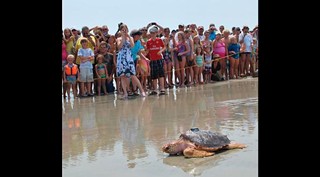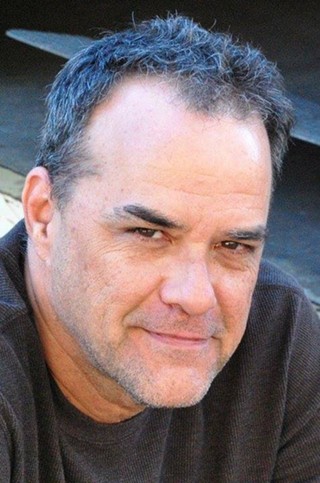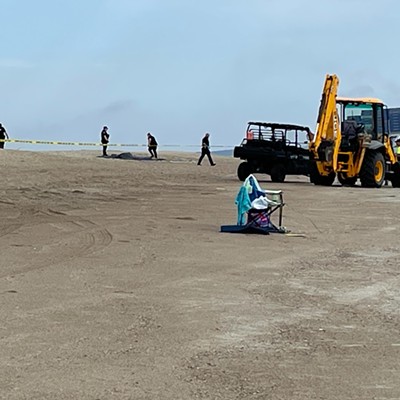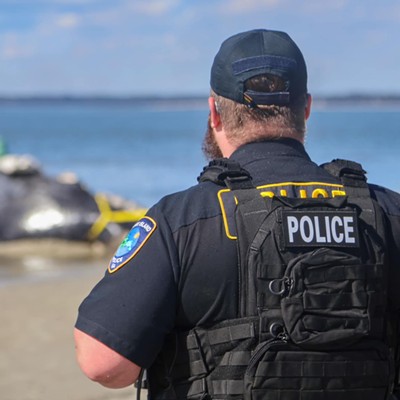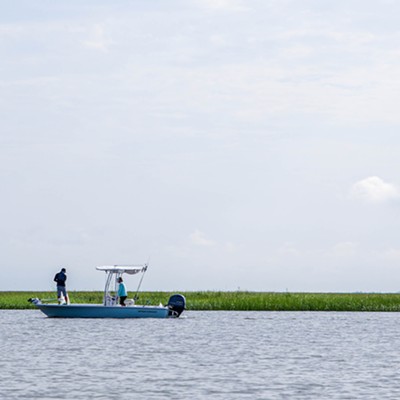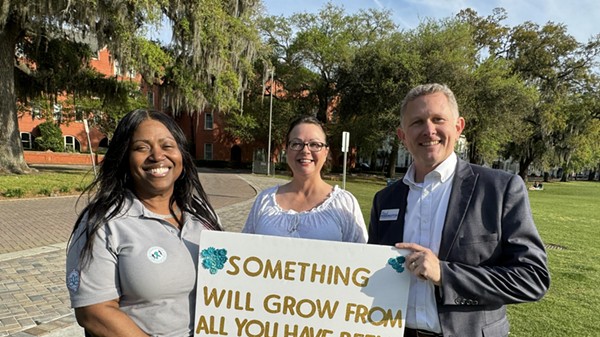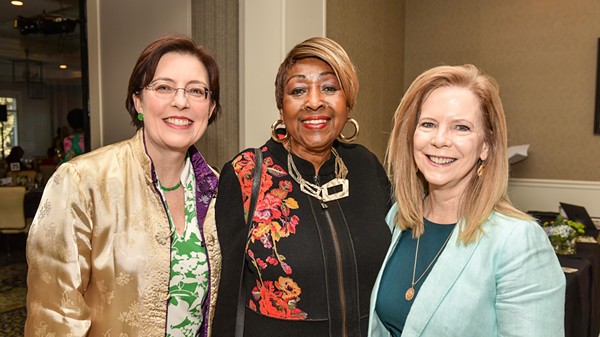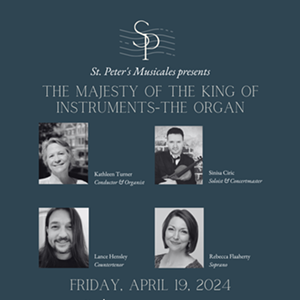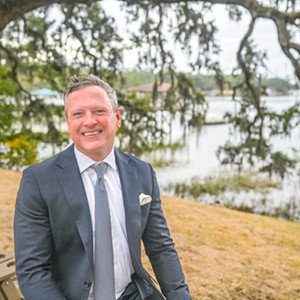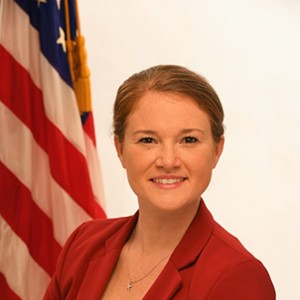So far in 2011, Tybee Island has been visited — always deep in the night — by nine female loggerhead sea turtles, who crawled out of the water, past the tide line, and clumsily dug a nest in the dry sand to deposit around 100 round, sticky white eggs.
When they’re done, the animals turn around and make for the water as fast as they can (and at an average of 350 pounds per turtle, they don’t move all that fast).
That’s a lot of little two–inch turtles that’ll hatch out in 50–60 days and wiggle their way back to the Atlantic.
Compare that with the Archie Carr National Wildlife Refuge, a 21–mile stretch of beach on the east coast of Florida. During the turtles’ nesting season, from early May into late August, it’s estimated that 200 loggerheads go through this ritual every night.
It’s the highest–density turtle beach in the Western Hemisphere.
Two other species, the green and leatherback, also come ashore there to perform their instinctual task. Since May, more than 15,000 turtle nests have been documented in the Florida refuge.
Tybee may be small, and not the preferred spot for these giant reptiles of the deep, but the island is proud of its efforts on behalf of sea turtles.
“It’s been a pretty average season for Tybee,” says Tammy Smith, who coordinates the city’s sea turtle program, a joint effort of the Georgia Department of Natural Resources and the Tybee Island Marine Science Center.
“Along with our nine nests, we’ve had 13 on Little Tybee. Last year, Tybee had 10. Although, statewide, it’s a really high season – we’re at just under 2,000 nests, which is much higher than last year. And so far, the highest number on record.”
Records weren’t kept, with any degree of scientific skill or certainty, prior to 1989. So historically speaking, the available info is sketchy.
Smith theorizes that it may not have been a whole lot different in pre–record keeping days.
The thing is, she says, “Tybee’s quite populated. We are a very developed island — us and St. Simon’s are the most developed in Georgia. We have a lot of human activity on our beach at night, all hours of the night, especially during the season. And we have a lot of lighting issues.”
Sea turtles seek the dark of night, and the cooler air, to conduct their extremely private business. And although low–level red lights (not visible to the turtle’s eye) were recently erected on the pier, Tybee is artificially white–lit from stem to stern.
“And also,” adds Smith, “Tybee is not considered a natural beach any longer, because we have to be re–nourished every seven years. So the habitat’s changing.”
That means there’s an unnatural slope from water’s edge to the tide line – something which tends to discourage a bulky animal that’s experiencing gravity for perhaps the first time in its life (once a sea turtle hatches and hits the ocean, it will never leave the water again — with the exception of the females during nesting season).
Smith’s volunteers at the Tybee Sea Turtle Project walk the beach each morning at sunrise, looking for the telltale tracks made by a nesting turtle.
Once they determine that a proper nest has been made (sometimes a turtle will “false crawl,” or turn around without digging and laying) they mark the nest with small, non–descript wooden stakes and a DNR sign that says, essentially, don’t get near this thing.
Loggerheads, as with all sea turtle species, are considered ecologically fragile (thank you, mankind) and are federally protected.
Happily, most people seem to understand that the big females, as well as the nests, eggs and the rarely–observed scurrying little guys, are off–limits. On many turtle beaches, predation from raccoons, wild hogs, armadillos and even coyotes takes its toll on eggs and hatchlings.
Mary Duncan, a spokesman for the Carr refuge in Florida, explains that a beach–lighting ban has been in effect there for many years. Even the Melbourne Beach Publix, which is across A1A from the ocean, closes early during turtle season, and douses every light.
“And there are very large areas where there’s no development at all, just dunes,” she says.
As of the last week in July, the breakdown for the refuge, most of which is in southern Brevard County, was this: 10,500 loggerhead, 4,000 green and 74 leatherback turtles.
Duncan says the entire 21 miles is patrolled every morning by several sanctioned volunteer organizations, including students from the zoology program at the University of Central Florida.
It’s illegal to possess a sea turtle, no matter its age or size, but Georgia DNR makes several exceptions where public education and enlightenment are concerned.
Since August of 2010, the Tybee Island Marine Science Center has had a juvenile loggerhead, nicknamed Salty, in an enormous display tank.
Salty was a “straggler” – he hatched normally inside a Tybee nest, but didn’t come out in the so–called “eruption” with his brothers and sisters.
(In truth, it’s impossible to determine the sex of a young sea turtle, so Salty may well be a “she.”)
One of Smith’s jobs is to “excavate,” five days after the babies have left, each Tybee nest. She counts the eggshells, and the bad eggs, and the number of hatchlings that, for whatever reason, didn’t leave the nest. The data goes straight to DNR.
The rescued hatchlings are released – late at night – into the ocean. Last year, however, Smith and the Tybee Center received permission to hang on to Salty.
He was barely two inches long when he arrived at the center. Now, at less than one year, he’s six times bigger.
“Education,” says Smith, “is a big part of what we do with the science center and our volunteers. Any chance we get, we want to educate people about sea turtles: They’re not the ones that are crossing Highway 80, they’re really big, and they’re very protected.
“It’s interesting to see what people know and don’t know. And they’re really excited when they get to actually see a sea turtle.”
In 2008, a straggler was retained, with DNR permission, by the Burton 4–H Center. “She hatched on Aug. 13,” says Amy Capello, who spent three years as one of the animal’s handlers. “And there were 13 babies left in the nest. Those were very unlucky numbers, so I didn’t want to name her Lucky.”
Capello dubbed the turtle Clover.
“A lot of people think the name ‘Clover’ had to do with 4–H, and I didn’t even think about that until later. But if the shoe fits ...”
This summer, Clover — well–fed and kept in water that was year–round warm — reached 50 centimeters, which is the DNR limit for captive sea turtles. At that size, there aren’t nearly as many aquatic predators that can eat them. So they get a pretty good head start.
(The same thing will happen to Salty when he reaches the designated safe size.)
Clover was returned to the Atlantic, with much fanfare, on Aug. 4. Attached to her shell on that hot Thursday afternoon was a satellite tracking transmitter, paid for by $5,000 in donations from the Tybee community.
Capello and the 4–H Center were also able to purchase a year’s worth of satellite time. This means that anyone who’s interested can go to seaturtle.org, click on “Track a Sea Turtle,” then “Georgia Sea Turtle Center,” and see where Clover’s oceanic travels take her.
The transmitter was attached with epoxy and will eventually fall off, as the turtle grows.
“The shortest time one stayed on was 19 days,” Capello says. “And the longest was over 400! So that leaves us with a lot of variability, and we just have no way to know. I’m shooting for the 400.”
Perhaps 1,200 people showed to watch as Capello placed Clover at water’s edge; they cheered as the young turtle began to crawl towards the surf, then turned around, confused, and looked up at her handler.
Eventually, Capello picked Clover up and carried her into the waves. And then she was gone.
(On Aug. 25, the UGA Marine Extension Service Aquarium will release Eddie, its own 3–year–old loggerhead, into the wild. Eddie, too, has reached the DNR size limit, and will returned to the sands of Wassaw Island, where he — or she? — was discovered as a straggler in 2008.)

